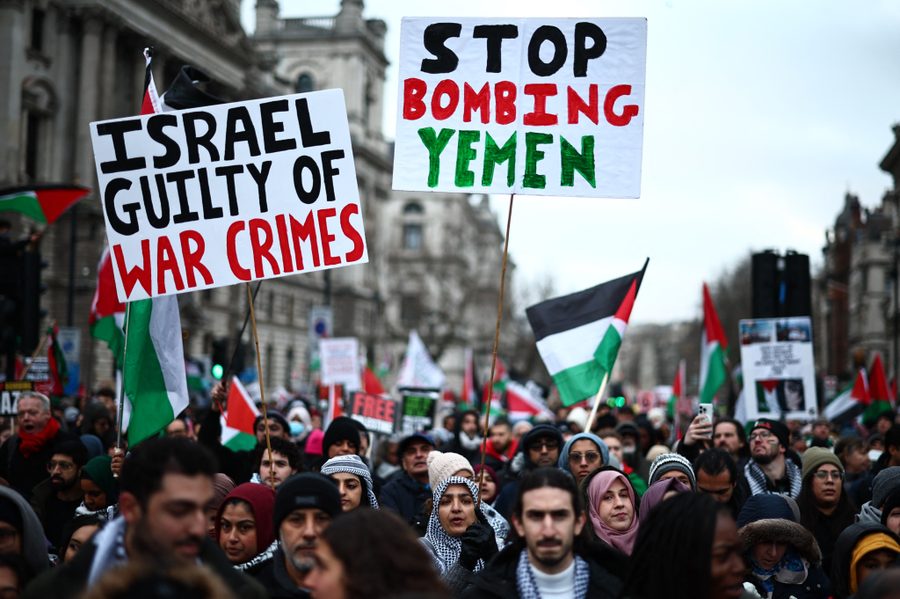The Only Solution to the Violence in Yemen and the Red Sea is a Cease-Fire in Gaza
U.S. strikes on Yemen are threatening a wider regional war. Diplomacy, not bombs, is the way to avoid a dangerous escalation.
Phyllis Bennis

As Washington continues to help arm and finance the Israeli government’s genocidal assault on Gaza, White House rhetoric has increasingly centered on preventing the war from expanding across the region. But the Biden administration’s actions in Yemen and the Red Sea are having exactly the opposite effect.
Beginning shortly after the Israeli assault on Gaza started in early October, Houthi militants from Yemen launched a series of attacks on commercial ships, some of them connected to the Israeli economy, in the shipping lanes in and around the Red Sea. The militants announced that their attacks were conducted to support the people of Gaza, and would continue until a cease-fire was put in place. While relatively little damage was done, the threat was taken very seriously, and shipping and insurance companies began re-routing large container ships away from the Red Sea to a longer route around Africa — adding significant time and cost to global shipping. This re-routing has the potential to cause serious problems in countries around the world that depend on global shipping lanes for export and import of everything from crude oil to children’s toys.
The day after Hamas’ Oct. 7 attack on Israel, the United States sent an entire aircraft carrier group to the region that was soon joined by two other destroyers and a 10-country armada of additional warships. On Dec. 31, the U.S. used helicopter gunships to sink Houthi attack boats in the Red Sea, killing 10 Houthi fighters. Less than two weeks later, on Jan. 12, the United States, backed by the UK, attacked 28 sites inside Yemen, killing at least 5 Houthi fighters and injuring 6 — the strike included Tomahawk cruise missiles fired from a ballistic missile submarine. And early on Jan. 16, Washington launched another cruise missile attack inside Yemen, allegedly targeting Houthi anti-ship missiles. Overall, violence is rapidly escalating across the already tense and highly militarized region.
But the notion that there is an effective military solution to the issue is a fantasy. What is required is serious diplomacy that starts by recognizing the fact that both Israel’s war on Gaza and U.S. support for that war are generating outrage across the Middle East — and some of that rage is turning into acts of retaliatory violence in Yemen and the Red Sea, as well as in Iraq and Syria where U.S. troops remain deployed. This diplomacy needs to start with a call for an immediate cease-fire to stop the slaughter in Gaza.
The Houthis, known officially as Ansar Allah (supporters of God), are an indigenous Yemeni Shi’a organization that has been contending for power in Yemen for decades. Iran has provided political, financial and military support to the Houthis over the years but they remain an independent Yemeni force.
Iran’s government has made clear it has no interest in a direct war with the United States or with Israel — and the forces in the Arab world it supports in Yemen and elsewhere do not operate under the orders of Tehran. In 2014, against the advice of Iran, the Houthis moved to seize Sana’a, the capital of the country, deposing the government that was recognized internationally and, crucially, supported by Saudi Arabia. By 2015, the civil war escalated as the Saudis, relying on U.S. arms and military support, launched a brutal air war against Yemen, devastating the impoverished country in what the UN has called (until Israel’s assault on Gaza) the worst humanitarian crisis in the world. A fragile cease-fire is in place right now, but the Houthis remain in control of significant parts of the country, including the capital, and have maintained their military capacity.
Along with deploying aircraft carriers to “deter Iran,” the United States says it is launching attacks against targets inside Yemen to “degrade Houthi rebels’ ability.” But years of far more intensive U.S.-backed Saudi bombing have failed to destroy Houthi military capacity, and this campaign will similarly fail to achieve the stated objectives.
It is not surprising that none of Washington’s current military actions are working to curtail the attacks in the Red Sea. Rather, they are dangerously worsening the already tense situation.
Urgent diplomacy is required. And ending Israel’s assault on Gaza remains the linchpin of any effort to calm the spreading regional violence. There is no military solution to military escalation in the Middle East: diplomacy is needed. And it needs to start with a cease-fire in Gaza now.
Phyllis Bennis is a fellow of the Institute for Policy Studies and serves as international adviser for Jewish Voice for Peace. She is the author of the new book Understanding Palestine & Israel, from Interlink.








